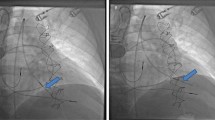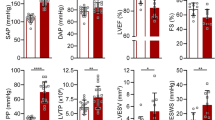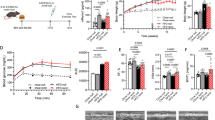Abstract
The pathogenesis of heart failure with preserved ejection fraction (HFpEF) remains unclear, and effective treatments are limited. HFpEF is more prevalent in females, indicating potential gender differences in its pathogenesis. However, no female HFpEF model animals have been established. Hypertension is a major contributor to HFpEF, and sympathetic activation is thought to play a role in both conditions. This study aimed to establish a female HFpEF model using hypertensive Dahl salt-sensitive rats and to assess the presence of sympathetic activation. Seven-week-old female Dahl salt-sensitive rats were fed an 8% high-salt diet (HS group, n = 6), while a low-salt diet group (LS group, n = 9) served as controls. The HS group exhibited increased systolic blood pressure and heart rate. Echocardiography revealed an increased left ventricular (LV) wall thickness, a decreased E/A ratio, and an increased E/e’ ratio, all indicative of diastolic dysfunction without reduced LV ejection fraction. Additionally, the HS group showed elevated LV end-diastolic pressure, LV weight, and lung weight, along with histological cardiomyocyte hypertrophy and interstitial fibrosis. Gene expression markers for cardiac hypertrophy and fibrosis were also increased. Renal function was significantly impaired, and plasma norepinephrine levels were elevated, consistent with heightened pre-sympathetic neuronal activity in the brain. In conclusion, high salt loading from 7 weeks of age in female Dahl salt-sensitive rats induced hypertensive HFpEF phenotypes with LV hypertrophy and fibrosis, and sympathetic activation by 16 to 19 weeks of age. This model provides a valuable tool for studying HFpEF pathophysiology in women.

This is a preview of subscription content, access via your institution
Access options
Subscribe to this journal
Receive 12 print issues and online access
269,00 € per year
only 22,42 € per issue
Buy this article
- Purchase on SpringerLink
- Instant access to full article PDF
Prices may be subject to local taxes which are calculated during checkout





Similar content being viewed by others
References
Yancy CW, Jessup M, Bozkurt B, Butler J, Casey DE, Drazner MH, et al. ACCF/AHA guideline for the management of heart failure: executive summary: a report of the American College of Cardiology Foundation/American Heart Association Task Force on practice guidelines. J Am Coll Cardiol. 2013;62:1495–539.
McMurray JJV, Packer M, Desai AS, Gong J, Lefkowitz MP, Rizkala AR, et al. Angiotensin–neprilysin inhibition versus enalapril in heart failure. N Engl J Med. 2014;371:993–1004.
Pieske B, Patel MJ, Westerhout CM, Anstrom KJ, Butler J, Ezekowitz J, et al. Baseline features of the VICTORIA (Vericiguat Global Study in Subjects with Heart Failure with Reduced Ejection Fraction) trial. Eur J Heart Fail. 2019;21:1596–604.
Zannad F, Anker SD, Byra WM, Cleland JGF, Fu M, Gheorghiade M, et al. Rivaroxaban in patients with heart failure, sinus rhythm, and coronary disease. N Engl J Med. 2018;379:1332–42.
Massie BM, Carson PE, McMurray JJ, Komajda M, McKelvie R, Zile MR, et al. Irbesartan in patients with heart failure and preserved ejection fraction. N Engl J Med. 2008;359:2456–67.
Pitt B, Pfeffer MA, Assmann SF, Boineau R, Anand IS, Claggett B, et al. Spironolactone for heart failure with preserved ejection fraction. N Engl J Med. 2014;370:1383–92.
Sotomi Y, Hikoso S, Nakatani D, Mizuno H, Okada K, Dohi T, et al. Sex differences in heart failure with preserved ejection fraction. J Am Heart Assoc. 2021;10:e018574. https://doi.org/10.1161/JAHA.120.018574
Triposkiadis F, Briasoulis A, Sarafidis P, Magouliotis D, Athanasiou T, Paraskevaidis I, et al. The sympathetic nervous system in hypertensive heart failure with preserved LVEF. J Clin Med. 2023;12:6486.
Grassi G, Seravalle G, Quarti-Trevano F, Dell’Oro R, Arenare F, Spaziani D, et al. Sympathetic and baroreflex cardiovascular control in hypertension-related left ventricular dysfunction. Hypertension. 2009;53:205–9.
Kaye DM, Nanayakkara S, Wang B, Shihata W, Marques FZ, Esler M, et al. Characterization of cardiac sympathetic nervous system and inflammatory activation in HFpEF patients. JACC Basic Transl Sci. 2022;7:116–27.
Klotz S, Hay I, Zhang G, Maurer M, Wang J, Burkhoff D. Development of heart failure in chronic hypertensive Dahl rats: focus on heart failure with preserved ejection fraction. Hypertension. 2006;47:901–11.
Kilfoil PJ, Lotteau S, Zhang R, Yue X, Aynaszyan S, Solymani RE, et al. Distinct features of calcium handling and β-adrenergic sensitivity in heart failure with preserved versus reduced ejection fraction. J Physiol. 2020;598:5091–108.
Mesquita T, Zhang R, Cho JH, Zhang R, Lin Y-N, Sanchez L, et al. Mechanisms of sinoatrial node dysfunction in heart failure with preserved ejection fraction. Circulation. 2022;145:45–60.
Pacher P, Nagayama T, Mukhopadhyay P, Bátkai S, Kass DA. Measurement of cardiac function using pressure–volume conductance catheter technique in mice and rats. Nat Protoc. 2008;3:1422–34.
Weiss JL, Frederiksen JW, Weisfeldt ML. Hemodynamic determinants of the time-course of fall in canine left ventricular pressure. J Clin Investig. 1976;58:751–60.
Iyonaga T, Shinohara K, Mastuura T, Hirooka Y, Tsutsui H. Brain perivascular macrophages contribute to the development of hypertension in stroke-prone spontaneously hypertensive rats via sympathetic activation. Hypertens Res. 2020;43:99–110.
Ikeda S, Shinohara K, Kashihara S, Matsumoto S, Yoshida D, Nakashima R, et al. Contribution of afferent renal nerve signals to acute and chronic blood pressure regulation in stroke-prone spontaneously hypertensive rats. Hypertens Res. 2023;46:268–79.
Elkholey K, Morris L, Niewiadomska M, Houser J, Ramirez M, Tang M, et al. Sex differences in the incidence and mode of death in rats with heart failure with preserved ejection fraction. Exp Physiol. 2021;106:673–82.
Adams V, Alves M, Fischer T, Rolim N, Werner S, Schütt N, et al. High-intensity interval training attenuates endothelial dysfunction in a Dahl salt-sensitive rat model of heart failure with preserved ejection fraction. J Appl Physiol. 2015;119:745–52.
Quiroz R, Doros G, Shaw P, Liang C, Gauthier DF, Sam F. Comparison of characteristics and outcomes of patients with heart failure preserved ejection fraction versus reduced left ventricular ejection fraction in an Urban Cohort. Am J Cardiol. 2014;113:691–6.
Yaku H, Ozasa N, Morimoto T, Inuzuka Y, Tamaki Y, Yamamoto E, et al. Demographics, management, and in-hospital outcome of hospitalized acute heart failure syndrome patients in contemporary real clinical practice in Japan―observations from the prospective, multicenter Kyoto Congestive Heart Failure (KCHF) Registry. Circ J. 2018;82:2811–9.
Silverman DN, Plante TB, Infeld M, Callas PW, Juraschek SP, Dougherty GB, et al. Association of β-Blocker use with heart failure hospitalizations and cardiovascular disease mortality among patients with heart failure with a preserved ejection fraction: a secondary analysis of the TOPCAT trial. JAMA Network Open. 2019;2:e1916598. https://doi.org/10.1001/jamanetworkopen.2019.16598.
Palau P, Seller J, Domínguez E, Sastre C, Ramón JM, de La Espriella R, et al. Effect of β-blocker withdrawal on functional capacity in heart failure and preserved ejection fraction. J Am Coll Cardiol. 2021;78:2042–56.
Verloop WL, Beeftink MMA, Santema BT, Bots ML, Blankestijn PJ, Cramer MJ, et al. A systematic review concerning the relation between the sympathetic nervous system and heart failure with preserved left ventricular ejection fraction. PLOS ONE. 2015;10:e0117332. https://doi.org/10.1371/journal.pone.0117332
Badrov MB, Mak S, Floras JS. Cardiovascular autonomic disturbances in heart failure with preserved ejection fraction. Can J Cardiol. 2021;37:609–20.
Kresoja K-P, Rommel K-P, Fengler K, von Roeder M, Besler C, Lücke C, et al. Renal sympathetic denervation in patients with heart failure with preserved ejection fraction. Circ Heart Fail. 2021;14:e007421. https://doi.org/10.1161/CIRCHEARTFAILURE.120.007421
Fallick C, Sobotka PA, Dunlap ME. Sympathetically mediated changes in capacitance: redistribution of the venous reservoir as a cause of decompensation. Circ Heart Fail. 2011;4:669–75.
Fudim M, Hernandez AF, Felker GM. Role of volume redistribution in the congestion of heart failure. J Am Heart Assoc. 2017;6:e006817
Fudim M, Litwin SE, Borlaug BA, Mohan RC, Price MJ, Fail P, et al. Endovascular ablation of the right greater splanchnic nerve in heart failure with preserved ejection fraction: rationale, design and lead-in phase results of the REBALANCE-HF trial. J Card Fail. 2024;30:877–89.
Perlini S, Palladini G, Ferrero I, Tozzi R, Fallarini S, Facoetti A, et al. Sympathectomy or doxazosin, but not propranolol, blunt myocardial interstitial fibrosis in pressure-overload hypertrophy. Hypertension. 2005;46:1213–8.
Noda M, Matsuda T. Central regulation of body fluid homeostasis. Proc Jpn Acad Ser B Phys Biol Sci. 2022;98:283–324.
Stocker SD, Kinsman BJ, Farquhar WB, Gyarmati G, Peti-Peterdi J, Sved AF. Physiological mechanisms of dietary salt sensing in the brain, kidney, and gastrointestinal tract. Hypertension. 2024;81:447–55.
Hirooka Y. Sympathetic activation in hypertension: importance of the central nervous system. Am J Hypertens. 2020;33:914–26.
Fujisawa Y, Nagai Y, Lei B, Nakano D, Fukui T, Hitomi H, et al. Roles of central renin-angiotensin system and afferent renal nerve in the control of systemic hemodynamics in rats. Hypertens Res. 2011;34:1228–32.
Ye C, Qiu Y, Zhang F, Chen A-D, Zhou H, Wang J-J, et al. Chemical stimulation of renal tissue induces sympathetic activation and a pressor response via the paraventricular nucleus in rats. Neurosci Bull. 2020;36:143–52.
Osborn JW, Tyshynsky R, Vulchanova L. Function of renal nerves in kidney physiology and pathophysiology. Annu Rev Physiol. 2021;83:429–50.
Katsurada K, Shinohara K, Aoki J, Nanto S, Kario K. Renal denervation: basic and clinical evidence. Hypertens Res. 2022;45:198–209.
Ong J, Kinsman BJ, Sved AF, Rush BM, Tan RJ, Carattino MD, et al. Renal sensory nerves increase sympathetic nerve activity and blood pressure in 2-kidney 1-clip hypertensive mice. J Neurophysiol. 2019;122:358–67.
Shinohara K. Renal denervation in patients with chronic kidney disease: an approach using CO2 angiography. Hypertens Res. 2024;47:1431–3.
Mori T, Polichnowski A, Glocka P, Kaldunski M, Ohsaki Y, Liang M, et al. High perfusion pressure accelerates renal injury in salt-sensitive hypertension. J Am Soc Nephrol. 2008;19:1472–82.
Mattson DL. Infiltrating immune cells in the kidney in salt-sensitive hypertension and renal injury. Am J Physiol Renal Physiol. 2014;307:F499–508.
De Miguel C, Das S, Lund H, Mattson DL. T lymphocytes mediate hypertension and kidney damage in Dahl salt-sensitive rats. Am J Physiol Regul Integr Comp Physiol. 2010;298:R1136–42.
Yao K, Sato H, Sonoda R, Ina Y, Suzuki K, Ohno T. Effects of benidipine and candesartan on kidney and vascular function in hypertensive Dahl rats. Hypertens Res. 2003;26:569–76.
Jin C, O’Boyle S, Kleven DT, Pollock JS, Pollock DM, White JJ. Antihypertensive and anti-inflammatory actions of combined azilsartan and chlorthalidone in Dahl salt-sensitive rats on a high-fat, high-salt diet. Clin Exp Pharmacol Physiol. 2014;41:579–88.
Arai K, Tsuruoka H, Homma T. CS-3150, a novel non-steroidal mineralocorticoid receptor antagonist, prevents hypertension and cardiorenal injury in Dahl salt-sensitive hypertensive rats. Eur J Pharmacol. 2015;769:266–73.
Naruse T, Otake H, Takahashi T. Effects of a lysophosphatidic acid receptor 1 antagonist on hypertensive renal injury in Dahl-Iwai salt-sensitive rats. J Pharmacol Sci. 2022;149:179–88.
Chiba H, Seo Y, Sai S, Namekawa M, Ishizu T, Aonuma K. Renoprotective effects of tolvaptan in hypertensive heart failure rats depend on renal decongestion. Hypertens Res. 2019;42:319–28.
Morooka H, Iwanaga Y, Tamaki Y, Takase T, Akahoshi Y, Nakano Y, et al. Chronic administration of oral vasopressin type 2 receptor antagonist tolvaptan exerts both myocardial and renal protective effects in rats with hypertensive heart failure. Circ Heart Fail. 2012;5:484–92.
Ishikawa M, Kobayashi N, Sugiyama F, Onoda S, Ishimitsu T. Renoprotective effect of vasopressin v2 receptor antagonist tolvaptan in Dahl rats with end-stage heart failure. Int Heart J. 2013;54:98–106.
de Couto G, Mesquita T, Wu X, Rajewski A, Huang F, Akhmerov A, et al. Cell therapy attenuates endothelial dysfunction in hypertensive rats with heart failure and preserved ejection fraction. Am J Physiol Heart Circ Physiol. 2022;323:H892–H903.
Kim MY, Pellot I, Bresee C, Nawaz A, Fournier M, Cho JH, et al. Diet modification reverses diastolic dysfunction in rats with heart failure and preserved ejection fraction. J Mol Cell Cardiol Plus. 2023;3:10003. https://doi.org/10.1016/j.jmccpl.2023.100031
Gallet R, De Couto G, Simsolo E, Valle J, Sun B, Liu W, et al. Cardiosphere-derived cells reverse heart failure with preserved ejection fraction in rats by decreasing fibrosis and inflammation. JACC Basic Transl Sci. 2016;1:14–28.
Budde H, Hassoun R, Mügge A, Kovács Á, Hamdani N. Current understanding of molecular pathophysiology of heart failure with preserved ejection fraction. Front Physiol. 2022;13:928232. https://doi.org/10.3389/fphys.2022.928232
Shah SJ, Kitzman DW, Borlaug BA, van Heerebeek L, Zile MR, Kass DA, et al. Phenotype-specific treatment of heart failure with preserved ejection fraction: a multiorgan roadmap. Circulation. 2016;134:73–90.
Upadhya B, Kitzman DW. Heart failure with preserved ejection fraction: new approaches to diagnosis and management. Clinical Cardiology. 2020;43:145–55.
Acknowledgements
This work was supported by grants from JSPS (KAKENHI Grant Numbers JP21K08032 and 24K11270) to KS.
Author information
Authors and Affiliations
Corresponding author
Ethics declarations
Conflict of interest
The authors declare no competing interests.
Additional information
Publisher’s note Springer Nature remains neutral with regard to jurisdictional claims in published maps and institutional affiliations.
Rights and permissions
Springer Nature or its licensor (e.g. a society or other partner) holds exclusive rights to this article under a publishing agreement with the author(s) or other rightsholder(s); author self-archiving of the accepted manuscript version of this article is solely governed by the terms of such publishing agreement and applicable law.
About this article
Cite this article
Nakashima, H., Shinohara, K., Matsumoto, S. et al. Establishment of a HFpEF model using female Dahl salt-sensitive rats: a valuable tool for elucidating the pathophysiology of HFpEF in women. Hypertens Res 48, 672–680 (2025). https://doi.org/10.1038/s41440-024-02025-7
Received:
Revised:
Accepted:
Published:
Issue Date:
DOI: https://doi.org/10.1038/s41440-024-02025-7



